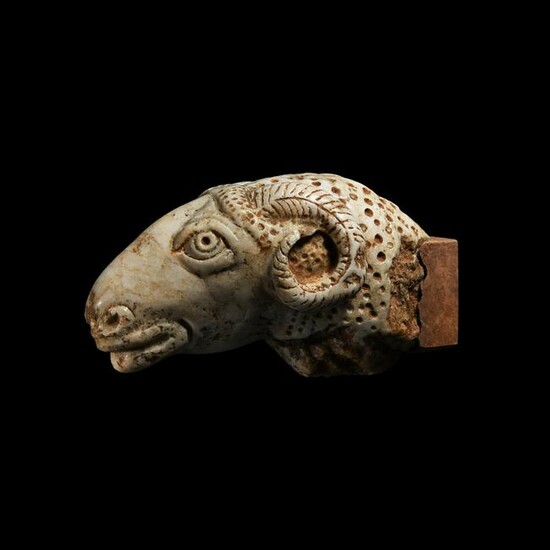Roman Ram's Head Finial
5th-6th century AD. An expertly carved marble head of a ram, originally part of a bigger sculpture, natural facial detailing with large almond-shaped eyes, the pupils with a recess for an inlay for the iris; the fleece with drilled locks; long curving horns with incised detailing; mounted on a custom-made display stand. See Mendel, G., Catalogue des sculptures grecques, romaines et byzantines, Constantinople, 1914, nos.21 (125), vol.I, p.102, for the sculpture of a ram’s head in similar style under the paws of a sphinx; vol.I, p.102; Grabar, A., L’Arte Paleocristiana, Milano, 1967. 1.4 kg total, 21cm including stand (8 1/4"). Property of a London gentleman; before that in the private collection of a Kensington collector; acquired from the private collection of Dr. Heinz Johanik, Austria, since 1970; accompanied by an academic expertise by Dr. Raffaele D’Amato and a geological scholarly report no.TL05387 by Dr Ronald Bonewitz; this lot has been checked against the Interpol Database of stolen works of art and is accompanied by AIAD certificate number no.10400-178135. The ram was the symbol of male strength and virility and was a commonly sacrificial animal from prehistory onwards. A ram's head appears next to the head of an ox or bull in a Graeco-Persian stele from the 5th century BC (Mendel, 1966, III, p.374, no.1357"). Symbol of Hermes, god of thieves, the ram's head frequently occurs in representations of sarcophagi and dedicatory steles from the Roman period, especially from the 2nd century AD. In the famous sarcophagus of Phaedra and Hippolytus, at the Istanbul Archaeological Museum, a sphinx holds the head of such a ram in its clutches, as well as in the Dionysian sarcophagus of the same museum. Four ram heads decorate the four corners of an altar dedicated to Nemesis, from Miletus (Mendel, 1966, III, p.78, no.864), a ram, with a similar pronounced head, accompanies the god Hermes in a statue of the 2nd century (Mendel, 1966, II, p.79, no.316) and the sacrificial animal becomes the primary subject of Asian steles to the deities (Mendel, 1966, III, nos.849-850-852-856"). Ram heads decorate the cymatia of the Roman imperial armour of the middle period (Mendel, 1966, III, p.346, no.1108; no.1373 p.585), but appears also in capitals (Mendel, 1966, II, p. 341, no.744; III, nos. 1210-1213), early Christian reliefs, sarcophagi and sculptures, as a tribute to the scene of the sacrifice of Isaac (Mendel, 1966, II, p.474, no.674), prow of ships (Mendel, 1966, II, p.431, no.655), or related to the new vision of the leader of the flock hold by the Good Shepherd (Mendel, 1966, II, nos.648-650, pp. 412ff.; Grabar, 1967, figs. 127,134,266,287,301,303"). In turn, this iconography certainly derives from that of Hermes carrying a ram on his shoulders (Kriophoros), being the famous Kriophoros of Salamis the original prototype, from which numerous copies were made in Roman times. [A video of this lot can be viewed on the Timeline Auctions website]
Condition Report: Fine condition.
View it on
Sale price
Estimate
Time, Location
Auction House
5th-6th century AD. An expertly carved marble head of a ram, originally part of a bigger sculpture, natural facial detailing with large almond-shaped eyes, the pupils with a recess for an inlay for the iris; the fleece with drilled locks; long curving horns with incised detailing; mounted on a custom-made display stand. See Mendel, G., Catalogue des sculptures grecques, romaines et byzantines, Constantinople, 1914, nos.21 (125), vol.I, p.102, for the sculpture of a ram’s head in similar style under the paws of a sphinx; vol.I, p.102; Grabar, A., L’Arte Paleocristiana, Milano, 1967. 1.4 kg total, 21cm including stand (8 1/4"). Property of a London gentleman; before that in the private collection of a Kensington collector; acquired from the private collection of Dr. Heinz Johanik, Austria, since 1970; accompanied by an academic expertise by Dr. Raffaele D’Amato and a geological scholarly report no.TL05387 by Dr Ronald Bonewitz; this lot has been checked against the Interpol Database of stolen works of art and is accompanied by AIAD certificate number no.10400-178135. The ram was the symbol of male strength and virility and was a commonly sacrificial animal from prehistory onwards. A ram's head appears next to the head of an ox or bull in a Graeco-Persian stele from the 5th century BC (Mendel, 1966, III, p.374, no.1357"). Symbol of Hermes, god of thieves, the ram's head frequently occurs in representations of sarcophagi and dedicatory steles from the Roman period, especially from the 2nd century AD. In the famous sarcophagus of Phaedra and Hippolytus, at the Istanbul Archaeological Museum, a sphinx holds the head of such a ram in its clutches, as well as in the Dionysian sarcophagus of the same museum. Four ram heads decorate the four corners of an altar dedicated to Nemesis, from Miletus (Mendel, 1966, III, p.78, no.864), a ram, with a similar pronounced head, accompanies the god Hermes in a statue of the 2nd century (Mendel, 1966, II, p.79, no.316) and the sacrificial animal becomes the primary subject of Asian steles to the deities (Mendel, 1966, III, nos.849-850-852-856"). Ram heads decorate the cymatia of the Roman imperial armour of the middle period (Mendel, 1966, III, p.346, no.1108; no.1373 p.585), but appears also in capitals (Mendel, 1966, II, p. 341, no.744; III, nos. 1210-1213), early Christian reliefs, sarcophagi and sculptures, as a tribute to the scene of the sacrifice of Isaac (Mendel, 1966, II, p.474, no.674), prow of ships (Mendel, 1966, II, p.431, no.655), or related to the new vision of the leader of the flock hold by the Good Shepherd (Mendel, 1966, II, nos.648-650, pp. 412ff.; Grabar, 1967, figs. 127,134,266,287,301,303"). In turn, this iconography certainly derives from that of Hermes carrying a ram on his shoulders (Kriophoros), being the famous Kriophoros of Salamis the original prototype, from which numerous copies were made in Roman times. [A video of this lot can be viewed on the Timeline Auctions website]
Condition Report: Fine condition.



